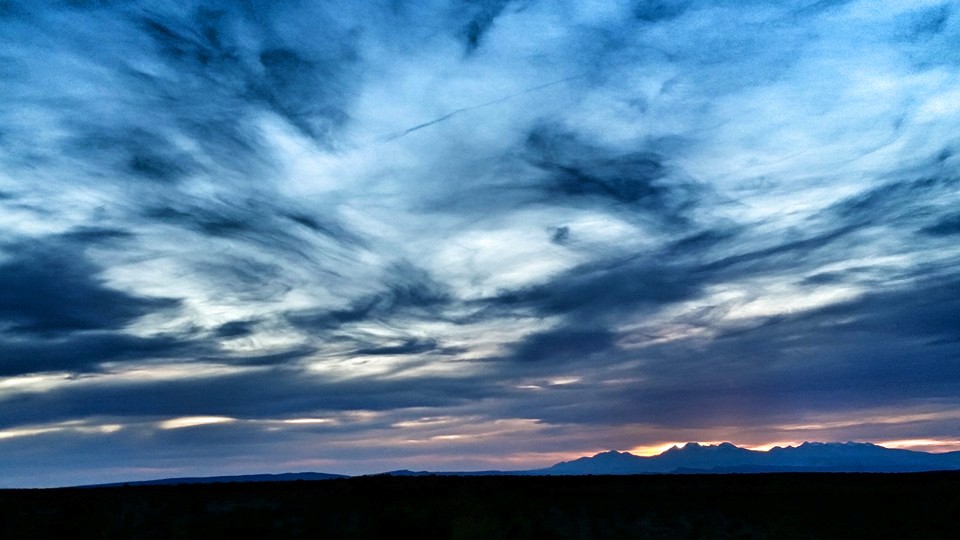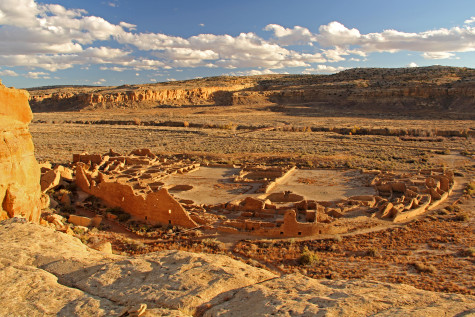
This post originally published May 12, 2015
With a calendar and Google Earth on my computer, you’d think I wouldn’t need the horizon any more, but I find I need it more than ever.
After 15 years living in the same house tucked into the West Elk Mountains of western Colorado, I moved this winter a few hours southwest into mesas and canyons looking from the edge of Colorado into Utah. The first thing I did in February, as if out of habit, was start noting the sunset position on the horizon. It was south over the rims of the Dolores River, and week by week I watched it roll north, approaching the La Sal Mountains, a set of snow-topped Batman Wings on the farthest horizon. Last night I stood outside at about 8:15 pm, daylight hours having drawn notably longer, and I saw that the sunset was now firmly in the house of the La Sals. I was beginning the first steps of feeling at home, knowing where I was in the spin and swing of the heavens.
Living in a place of big horizons and sharply rendered landmarks is like having your own Stonehenge. The landscape naturally sets up alignments with the sky that people have recognized throughout time. The Southwest is decorated with pre-Columbian rock art placed where lunar and solar cycles manifest onto painted or pecked images, casting light and shadow through gaps in the rock. The whole landscape was a calendar and people recognized it with their art.
A park ranger told me that when he moved to Chaco Canyon, New Mexico, one of the largest, most intact early Pueblo settlements in the Southwest (dating back to at least 1100 A.D.), sunrises became his specialty. It became a pastime of his, like morning yoga, to go to particular spots where at certain times of the year he knew the sunrise would be dramatically framed by shapes on the horizon. He kept track of the first shoestrings of light slipping through arches and boulder gaps, tracing them to where, for a moment, they touched a pointed rock tip of hole in the cliff wall. He said that this pursuit felt natural in this particular land, with the sky so huge overhead and the horizon picketed with cliffs and buttes. You can’t help looking for the peculiar way the sun rises or sets from one day to the next.

In Chaco, at least 11 major, multi-acre structures appear to have been designed to be architectural calendars, letting the sun or moon cast its light through their rooms, windows and doors in a premeditated fashion. Some are oriented toward the 18.6-year lunar standstill cycle, others toward the spring and fall equinoxes or the solstices of winter and summer. When the sun reaches its daily apex, the long middle wall of the largest structure, Pueblo Bonito with more than 800 rooms, casts no shadow regardless of the day of the year.
People back then clearly took note of the relationship between earth and sky. At Parowan Gap in Utah, a pair of rocky hills form a V and on the summer solstice, the sun sets directly into the crook of that V. The gap itself is awash in rock art, a placement that wouldn’t seem clear unless you happened to arrive for this sunset.
Another key location is Chimney Rock in southern Colorado. A pair of natural rock towers rise from the top of a high, narrow butte. Every 18.6 years when the moon reaches its northernmost point on the horizon — an event known as the Lunar Standstill — the full moon of that winter solstice rises directly through the narrow gap between the towers. The top of this butte, with a perfect view through the towers, happens to be crowded with masonry circles that mark subterranean ceremonial chambers known as kivas. Wood cores taken from prehistoric timbers used in these kivas reveal that major construction episodes happened every 18.6 years.
The last standstill was in 2006 and that December I joined a small group of scientists and observers who climbed the butte of Chimney Rock on a clear and frigid afternoon. We gathered in heavy coats with cameras set up around us, and at sunset we watched the full moon rise exactly as it was supposed to through the gap. An astrophysicist present for the event commented that this must have been a powerful thing to witness long ago. Wistfully, he said it was too bad no one worshiped this particular moonrise anymore. I wondered, did he not see this cluster of cameras we had in a windy December chill atop this ride just to watch a single moonrise? In my mind this was an unquestionable form of worship, even if scientific.
These alignments are everywhere. Plant a stick in the ground and you can use it as a clock. Stay around for long enough and it will become a calendar, and soon from that fixed point you will begin to notice the longer patterns of the moon. In your house you can watch the way the light slants through your windows from day to day. The passage of shadows over thresholds and through the kitchen becomes your alignment.
Whatever solid I can find on my horizon, I hang onto it. I watch light slip around it. This worship of the heavens has become second nature as I step outside every sunset to keep track of the tilting sky, trying to make of myself a fixed point.
Images: Craig Childs/Shutterstock
That’s a great piece. Thank you. I’m fortunate to have many stone circles, megaliths and other sites near me. I wrote a similarly-inspired piece after watching the light and shadows on an ancient site behind my home in Scotland: http://www.duckrabbit.info/2013/01/shadowdance/
Love this article. Thank you Craig.
We whirl toward the sun and away. Always moving. Our houses, cars, names, loves and despairs falling into the light, falling away, some atom of bedrock in us longing to be fixed somewhere.
I was part of Kim Malville’s archaeoastronomy field crew in 1988, and got to watch the moon rise between the chimneys on one memorable evening that summer. Thanks to that season, I too note the migrations of sun and moon along my lumpy Colorado horizons. I missed the last standstill period, but I am reminded to mark my calendar (a paper one: more transient than the earth, but old-school nowadays, I guess) to make a pilgrimage to Chimney Rock for the next. Thank you.
Andrea, Kim was my mentor at CU and a significant influence on my life. I never saw time and humanity the same way again.
My sister used to live in apartment building in Manhattan with a view of New Jersey and the Palisades. You could tell the approximate date by where the sun set relative to the buildings across the Hudson.